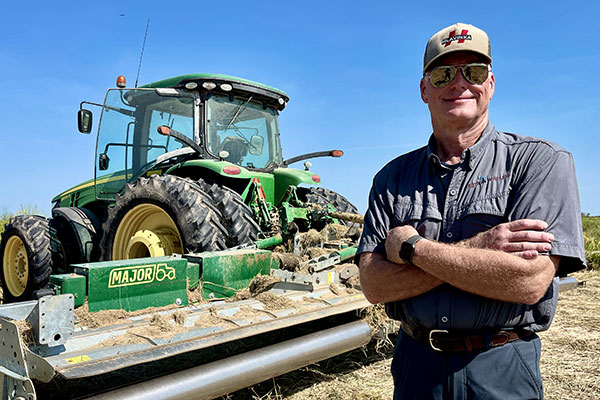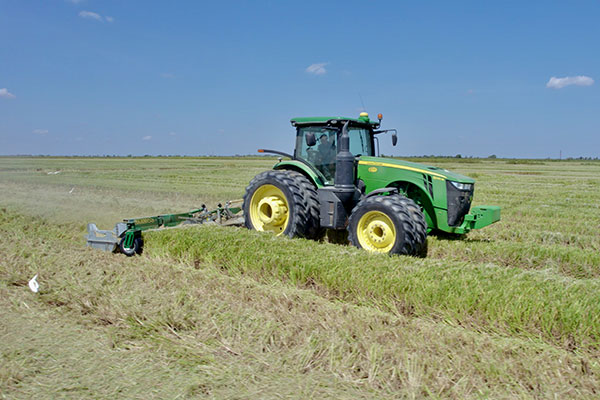Improving Ratoon Crop in Extended Drought
Major Cyclone 30-ft shredder allows Gertsons to increase efficiency managing rice stubble leading to improved ratoon crop in Texas rice belt.
Fourth generation Wharton County, Texas, rice farmer and cattleman Stephen Gertson kicks the dirt next to his farm shop in Lissie, Texas, and watches a small plume of dust drift off in the wind. The land is flat. There are very few trees and even less water. Therein lies the problem.
“When you farm rice, you’ve got to have water,” says Gertson, who farms with his brothers, Danny, Ronald, John and their dad, Dan. Their spouses also work the farm. It’s a true family operation. “We usually harvest two rice crops each year.”
The work starts in January or early February with an application of a pre-plant fertilizer. Typically, a good rain will incorporate the application leading to a good surface pack. After an application of fertilizer, the Gertsons will begin planting on the stale seedbed usually around the 15th of March.
“It’ll take us from early March to the middle of April to get all our acreage planted if Mother Nature cooperates,” said Gertson. “Part of our production we grow as contracted seed rice and the rest is paddy rice.”
After the first crop is cut, they “close up the holes” in the levees, reflood and begin farming toward their ratoon, or second crop, which is usually harvested in late October or early November.
In 2022, the Gertons could only second crop on ground they could flood with ground water from their wells that are as deep as 800 feet, with pumps set around 300 feet.
“The aquifer our wells pull from is closely monitored and there are strict limits on how much we are allowed to pump,” said Gertson. “We are in an 18-month drought with no end forecasted in the near future. Two of the Highland Lakes, Buchanan and Travis, are the region’s water supply reservoirs pressured by more than 1 million people as well as business, industries, the environment and agriculture in the lower Colorado River basin. Currently, both of those lakes are much lower than usual. That will also limit our water availability in the 2023 production year.”
“Industrial growth in Austin is placing added pressure on already limited water supplies from the Colorado,” said Gertson. “Water battles have been going on around here for decades.”
Efficiency gains with new Major Cyclone
All the rice ground farmed by the Gertsons has been precision leveled to improve water use efficiency.
“Laser-controlled land levelling helped us reduce the amount of water we need each year to produce a rice crop,” said Gertson. “We saw improved crop establishment and increases in our grain yield and quality thanks in no small part to our gains in water use efficiency.”
By mid-May, all rice ground will be in permanent flood until mid-July when they open the levees. Ten days later, combines will roll to harvest the season’s first crop. By the middle of August, levees are closed and water is pumped in to reflood and begin working toward their ratoon harvest.
The Gertsons had been using a flail shredder to manage rice stubble post-harvest. It was getting long in the tooth, seemed to get out of balance often, and the machine’s gear boxes gave them more problems than they had time to deal with. So, they began searching the internet for options.
“We had an idea what we wanted, but we didn’t know if a mower existed that would meet our expectations,” said Gertson. “We searched on YouTube and ran across a few videos of the Cyclone manufactured by Major Equipment Company and we were initially impressed because of how it can be pulled behind a tractor.”
The first thing catching their attention was Cyclone’s ability to be folded. They also wanted a shredder that would cover a 30-foot swath.
It’s 30-feet of working width can fold into 13’9” of travel width. With ten rotors and 40 blades, its 1000 PTO rpms make it a force in the field.
“We like the potential we saw in the Cyclone shredder,” said Gertson.
“Once we start cutting rice, we move as quickly and safely as we can. The Cyclone’s ability to fold and go helps us do just that with only one farm hand.”
Gertson knows he has increased overall harvest efficiency with the Cyclone thanks to its basic 3-point operation.
“We pull the locks, fold it and move on to the next field,” adds Gertson. “And depending on weather conditions and the regrowth stage of the rice stubble, we can run from 5 to 7 mph.”
If the rice stubble is a little green, they might have to slow down some, but the Cyclone allows them to keep up with three combines running simultaneously. Cutting the stalks lets air and sunlight penetrate down to the roots and kickstart ratoon growth.
“Although I haven’t put pen to paper to quantify the savings the Cyclone delivers, there are some things we are just able to see as we harvest,” said Gertson. “One of those things is getting done in a timely manner.”
The Cyclone allows them to move quickly from field to field before the ground dries out too much. That is important because you can’t move water as effectively across the field on dry ground that wants to soak in that reflood water.
Less maintenance, galvanization reduces total ownership costs
Gertson also praises the gearbox driveline and operational simplicity. “It has a lot less moving parts than a flail shredders so a lot less maintenance,” he explains. “We constantly had trouble balancing the old flail shredder if the blades hit something, so we’ve eliminated that by using something with a lot less moving parts.”
“There’s 40 blades on this where there’s probably 400 on a 30 ft flail shredder.”
The Gertsons’ operation is 70 miles from the Gulf of Mexico. They live in a very corrosive environment for equipment. The topside of the Cyclone is made from high-performance Strenx™ 700 M structural steel, while Hardox® 450 abrasion-resistant steel on the Cyclone’s undersole ensures a long wear life.
“The fact that it’s made from galvanized steel is another feature we like about the Cyclone,” adds Gertson.
“Major Equipment shows their dedication to the product and to farmers.”
After sales support is important and Major has shown their dedication to the product and to farmers. “Anytime I’ve had a question, they’ve responded quickly. Or they follow up on a phone call and double-check everything works out.”
“I’d recommend the Major Cyclone cutter to any rice farmer that’s trying to maintain their stubble for second crop growth. It’s made it a lot easier for us to get our job done.”




